There have been 426 species of birds recorded in subtropical Mississippi state since records began, and more than 20 of them are sparrows.
The best time of the year to see sparrows in this warm, humid part of the continent is in the winter. The mild Mississippi winters offer a welcome refuge for many sparrows looking to escape the colder weather further north.
During the hot summers, most sparrows prefer to migrate north to breed, often flying well into Canada or all the way to Alaska for nesting. Only a few species remain here during this time.
Mississippi residents can attract several types of sparrows to their gardens during the winter by offering them food from backyard bird feeders. It can also be great fun watching sparrows bathe themselves in a purpose-made bird bath or garden pond.
Other rarer sparrow species require a dedicated trip to wild habitats such as coastal marshes for a decent chance of a sighting. Sadly, many of these niche habitats are threatened, and several sparrow species desperately need our help to protect and restore their native lands.
Here we’ll take a look through 25 sparrow species in Mississippi, starting with the most common, and finishing off with a brief look at the very rarest.
25 Sparrows in Mississippi, Starting With the Most Common
Eastern Towhee

- Species Name: Pipilo erythrophthalmus
- Length: 6.8-8.2 in (17.3-20.8 cm)
- Weight: 1.1-1.8 oz (32-52 g)
- Wingspan: 7.9-11.0 in (20-28 cm)
Eastern towhees are the most common sparrow in Mississippi and are fantastic-looking birds. Their black, tufted crest, white breast, and red flanks make them one of the most colorful of all sparrows in North America. Weighing nearly two ounces, they’re also one of the biggest.
Whereas many sparrow species migrate to more northerly states during the breeding season, eastern towhees are more common in Mississippi during the summer than in winter. Nevertheless, they are a common sight here year-round.
Eastern towhees can be attracted to your backyard by offering them a weedy, shrubby corner where they can scratch about in the undergrowth. They may also accept offerings at your backyard feeder including sunflower seeds and peanuts.
White-throated Sparrow
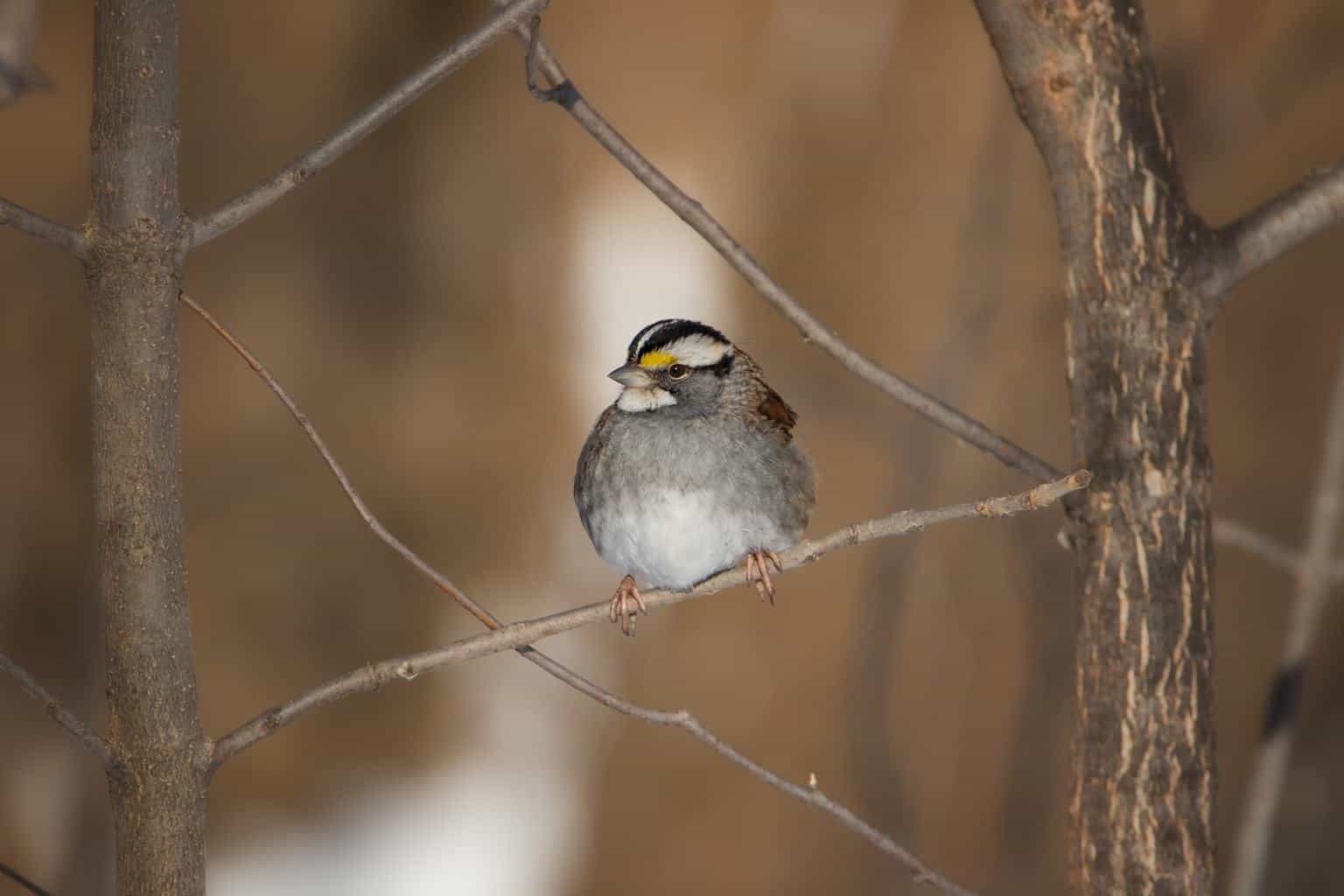
- Species Name: Zonotrichia albicollis
- Length: 6.3-7.1 in (16-18 cm)
- Weight: 0.8-1.1 oz (22-32 g)
- Wingspan: 7.9-9.1 in (20-23 cm)
Despite only being a winter visitor in Mississippi, the sheer number of white-throated sparrows during the colder months makes them the second-most common sparrow in the state.
These medium-sized sparrows have distinctive black and white (or light brown) stripes on the crown of their heads, yellow eyebrows, and light gray-colored chests. The melancholic whistling song of this common bird is also quite singular and easy to recognize.
This sparrow enjoys flocking during the winter months and will often join mixed flocks with other sparrow species. They’re typically seen in mixed woods and hedges but can be tempted to visit backyards in search of food as well.
House Sparrow

- Species Name: Passer domesticus
- Length: 5.9-6.7 in (15-17 cm)
- Weight: 0.9-1.1 oz (27-30 g)
- Wingspan: 7.5-9.8 in (19-25 cm)
With their black ‘beard’ on their light gray chest, the iconic male house sparrow is easy to recognize. The brown females are less distinctive but are normally seen accompanying the males.
House sparrows were introduced to the United States in 1852 from Europe and their presence has been met with a mixed reception. Because house sparrows don’t migrate, they can often dominate the nesting grounds of native birds.
On the plus side, there’s no denying that house sparrows have their charm, and their noisy flocks can bring cheer to dull winter days. House sparrows can be regularly seen year-round in Mississippi, especially around human habitation.
Chipping Sparrow
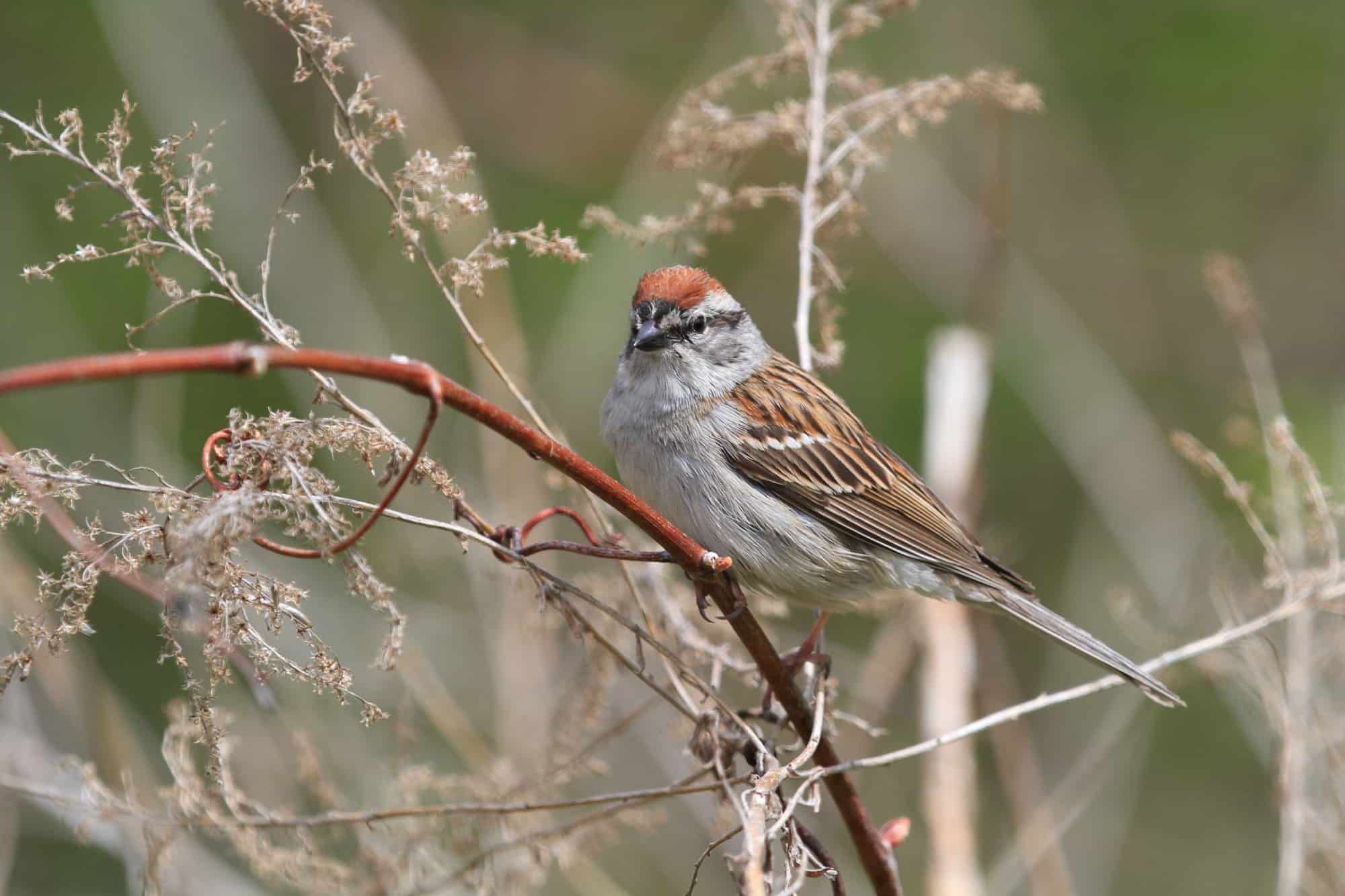
- Species Name: Spizella passerina
- Length: 4.7-5.9 in (12-15 cm)
- Weight: 0.4-0.6 oz (11-16 g)
- Wingspan: 8.3 in (21 cm)
Chipping sparrows are closely related to clay-colored sparrows and Brewer’s sparrows, but can be distinguished by their highly pronounced eye line and rusty crown. Their trilling call is also one of the noisiest and most persistent in the woodland spring chorus, so it’s a useful one to recognize!
These are some of the most widespread sparrows in North America, with a scattered breeding range stretching from Mexico to Alaska. They typically fly around in small flocks, often mixed with other sparrows.
Chipping sparrows are absent from the very southern and western fringes of Mississippi during the breeding season, but in the rest of the state, they can be found year-round.
Swamp Sparrow
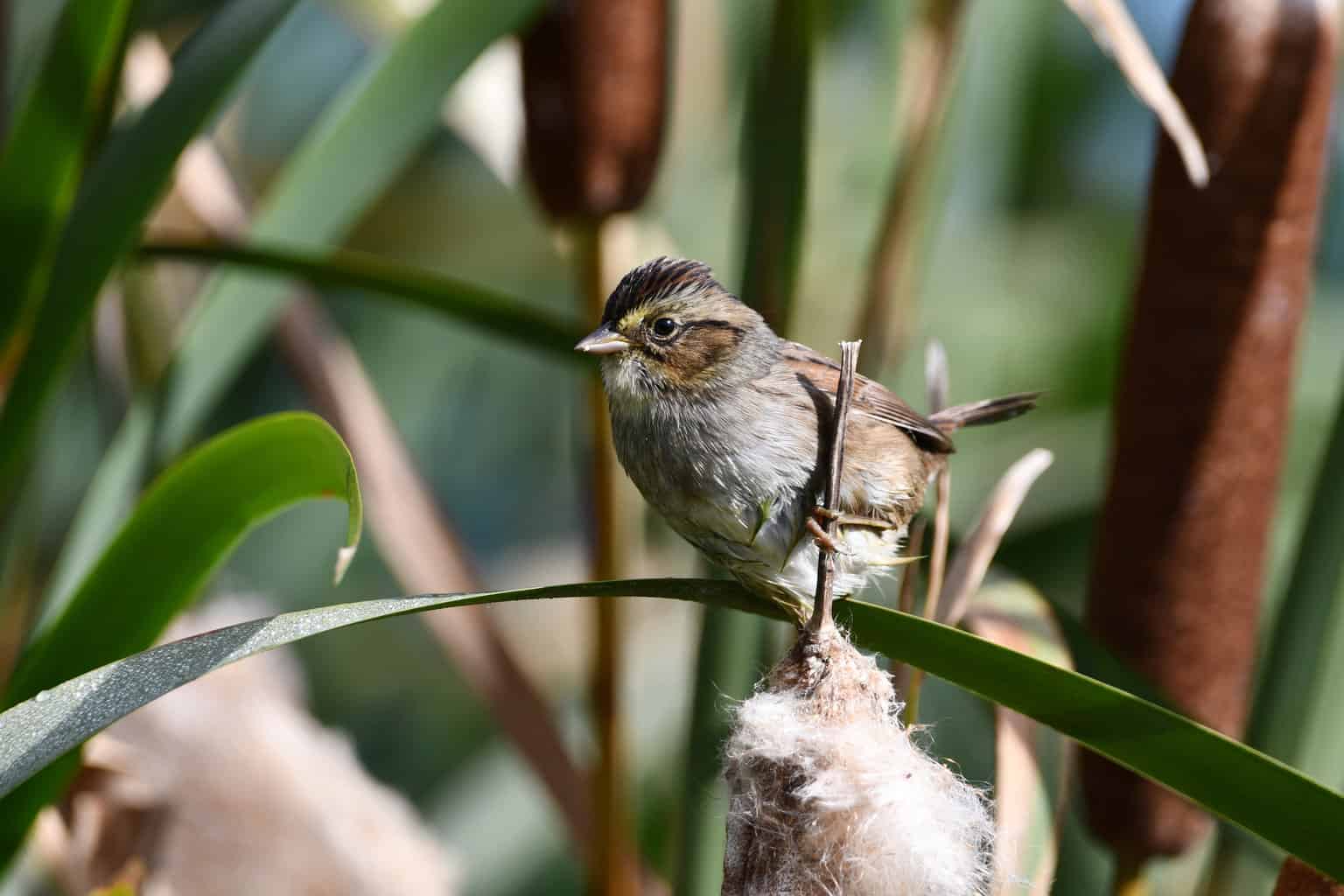
- Species Name: Melospiza georgiana
- Length: 4.7-5.9 in (12-15 cm)
- Weight: 0.5-0.8 oz (15-23 g)
- Wingspan: 7.1-7.5 in (18-19 cm)
The brown cap and black eye line are the most commonly described field marks of the swamp sparrow, but they also have a singular call which, to my mind, sounds a bit like mocking laughter!
One of the smallest sparrows in the United States, the swamp sparrow has an impressive migratory range that extends from Central America all of the way up to Northern Canada. Mississippi is a common wintering ground for these tiny sparrows when they can be found throughout the state in wetlands and weedy fields.
You may notice an increased number of swamp sparrows around Mississippi during the spring and fall migration seasons. You can try to persuade these endearing, water-loving birds to stop off in your backyard by offering them a garden pond or bird bath.
Dark-eyed Junco
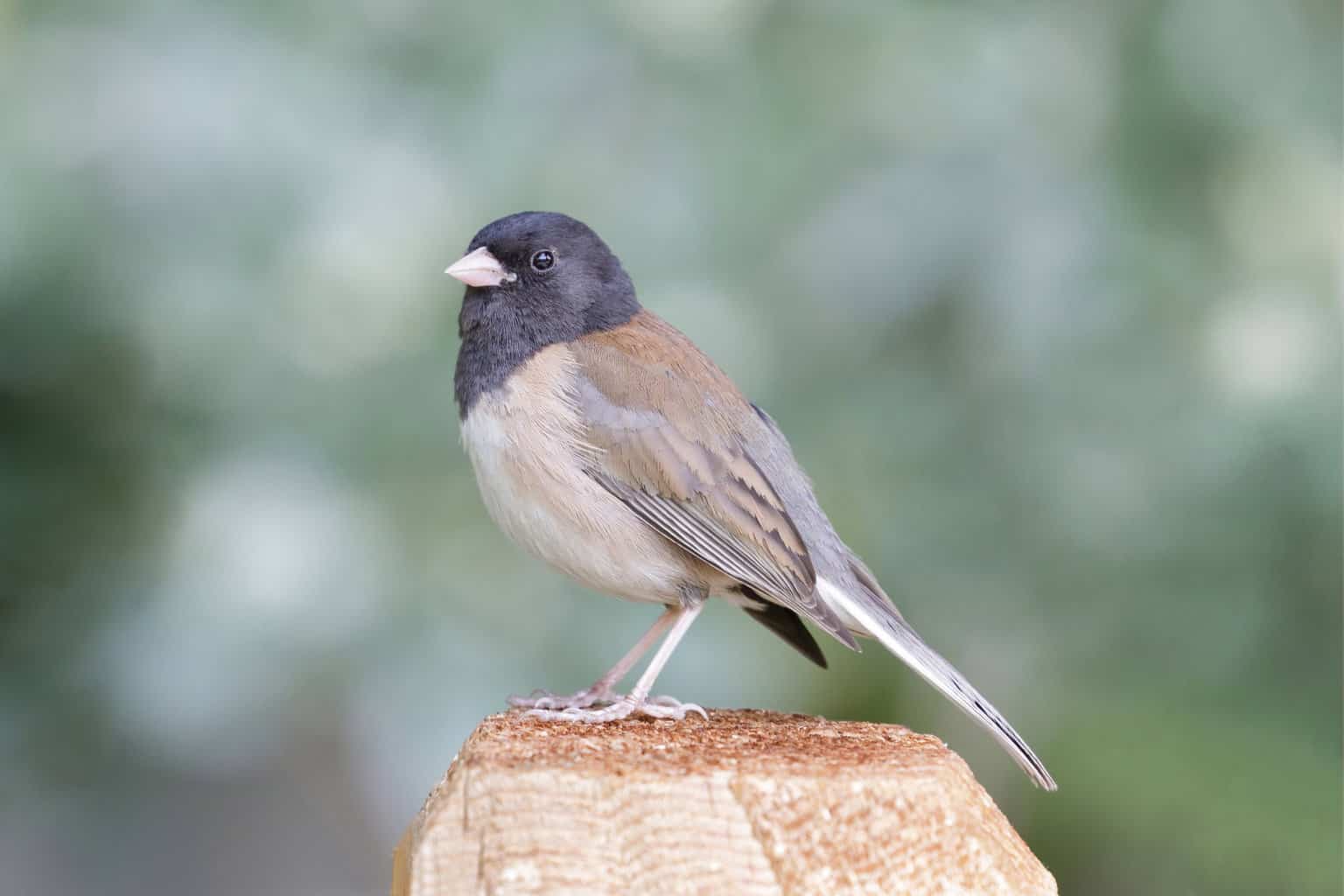
- Species Name: Junco hyemalis
- Length: 5.5-6.3 in (14-16 cm)
- Weight: 0.6-1.1 oz (18-30 g)
- Wingspan: 7.1-9.8 in (18-25 cm)
The subspecies of dark-eyed junco you’ll see in Mississippi will almost certainly be the aptly-named slate-colored variety. The red-bodied Oregon subspecies is only a very occasional vagrant here.
Male slate-colored dark-eyed juncos have a dark gray upper body, and a white chest, but females can vary from having a slight brown tint to a full-light brown upper body and white undersides.
Sometimes also known as the ‘snow bird’, dark-eyed juncos are incredibly hardy sparrows that can be seen in every state of the mainland continent. They’re often seen in backyards, and will readily accept food from backyard feeders.
They’re less common in Mississippi than in many other states, and you can only find them in the state during the winter. Perhaps it’s just not cold enough for them here!
Song Sparrow

- Species Name: Melospiza melodia
- Length: 4.7-6.7 in (12-17 cm)
- Weight: 0.4-1.9 oz (12-53 g)
- Wingspan: 7.1-9.4 in (18-24 cm)
Song sparrows are part of the common Melospiza sparrow family and it can be difficult to distinguish them from sight alone. Luckily, song sparrows are one of the most vocal of all songbirds, and learning their song is the best way to get a positive identification.
Interestingly, scientists have discovered that song sparrows adapt their song according to their environment – their country song is different from the one they sing in the city!
These beautiful sparrows are purely winter visitors in Mississippi when you’ll find them in open brushy areas and around suburban parks and gardens. An enthusiastic visitor to your backyard feeder, these common birds will lap up black oil sunflower seeds and millet that you leave out for them.
Savannah Sparrow
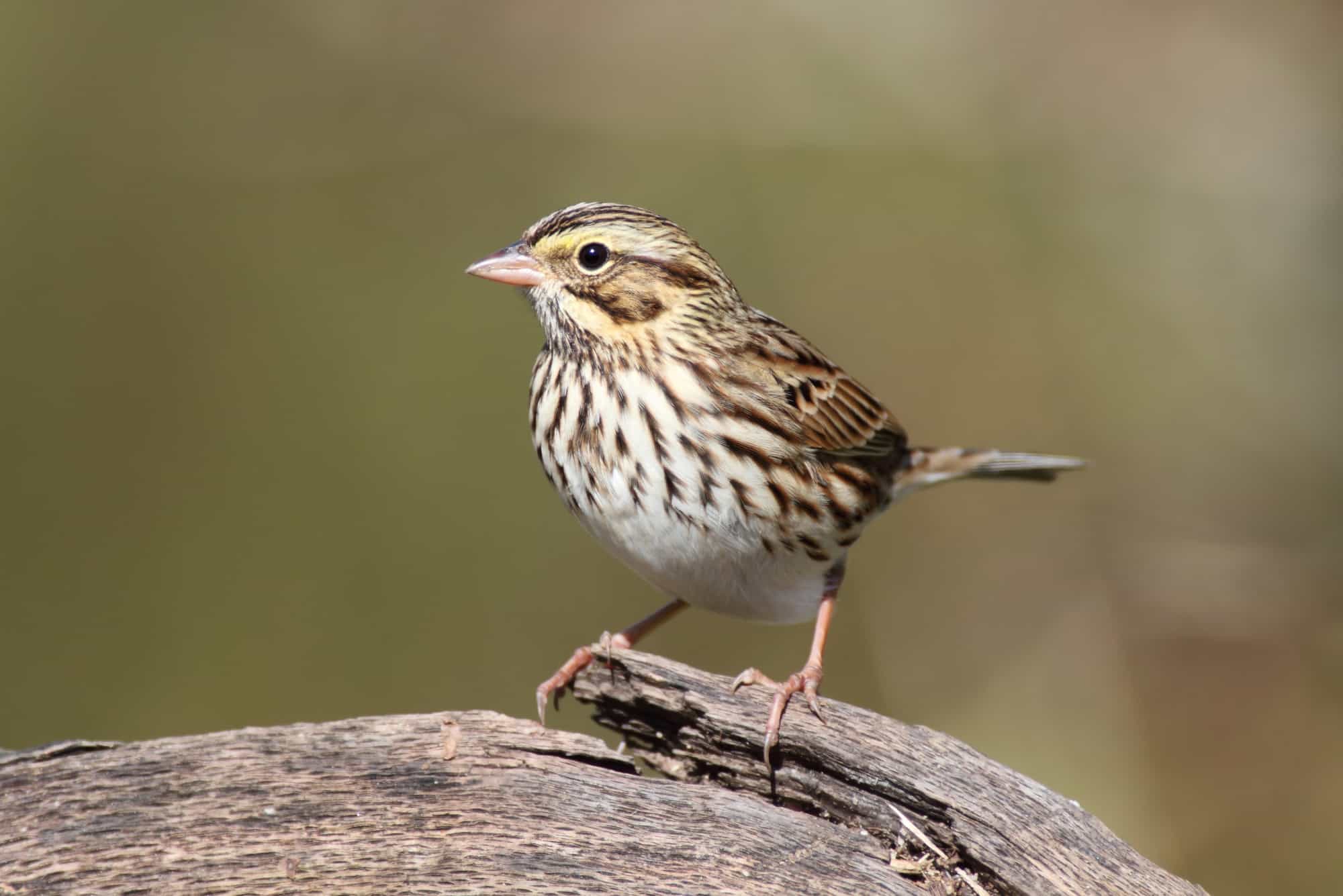
- Species Name: Passerculus sandwichensis
- Length: 4.3-5.9 in (11-15 cm)
- Weight: 0.5-1.0 oz (15-28 g)
- Wingspan: 7.9-8.7 in (20-22 cm)
Savannah sparrows are one of the most genetically diverse of all sparrow species, and their various subspecies can have slightly different plumage variations. In general, though, these medium-sized sparrows have light, speckled chests, and yellowish tinting around their eyes.
Savannah sparrows are classed as purely winter visitors in Mississippi, where they prefer life out in weedy grasslands. They mostly forage for wild seeds in the winter, so you’re unlikely to see them near human habitation.
Take a pair of binoculars and look out for them perched on top of weeds or boundary fences.
Field Sparrow
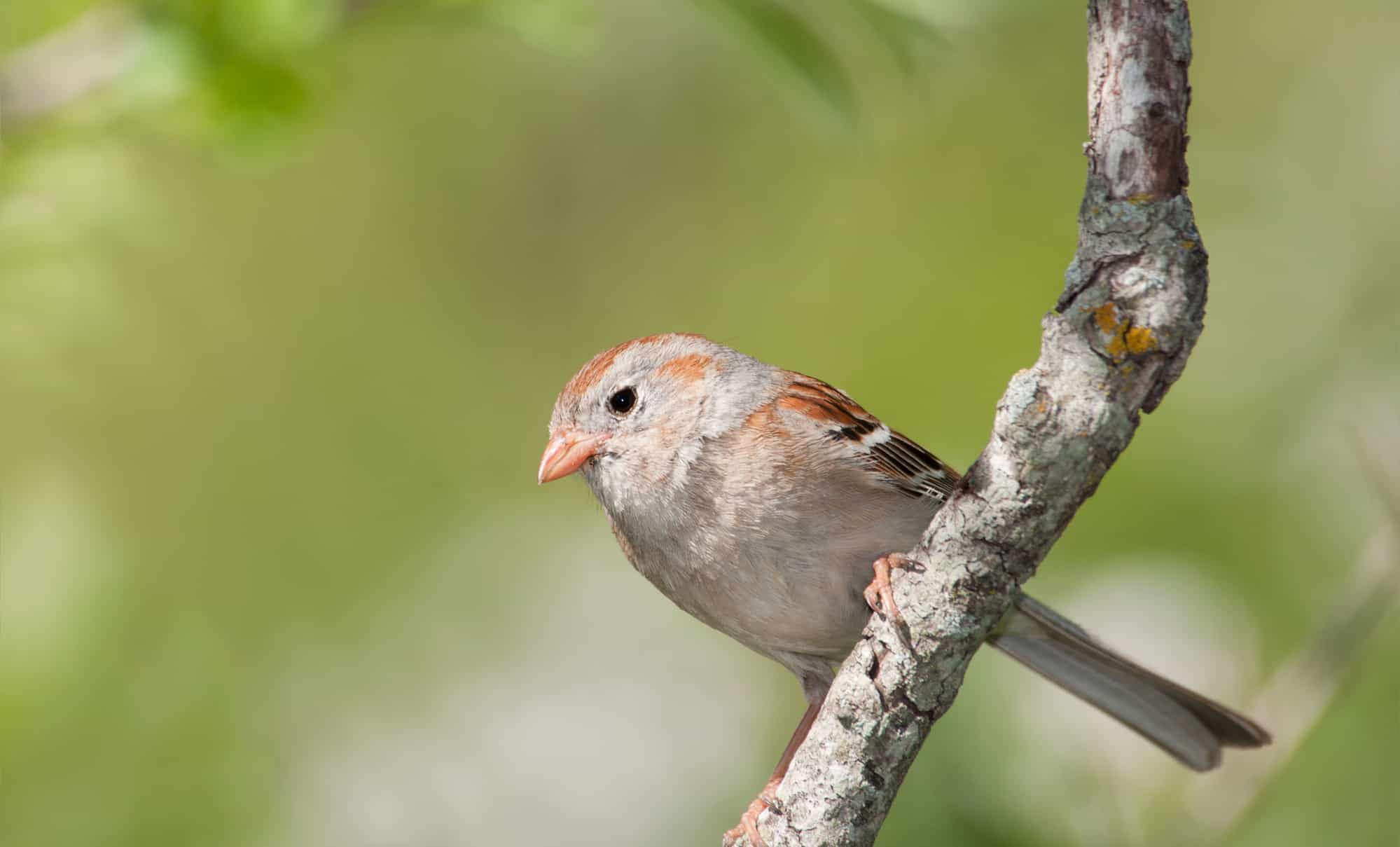
- Scientific Name: Spizella pusilla
- Length: 4.7-5.9 in (12-15 cm)
- Weight: 0.4-0.5 oz (11-15 g)
- Wingspan: 7.9 in (20 cm)
A cousin of the chipping sparrow, the slightly more orange-colored field sparrow is fairly difficult to distinguish by appearance alone. It’s easier to tell them apart from similar-looking species by their loud, high-pitched call that sounds bizarrely like a metallic bouncing ball coming to a stop!
According to my Sibley Guide to Birds, field sparrows can be found throughout the year in Mississippi. They nest on the ground and, once hatched, their young only take about one week to fledge!
Although they are common, their numbers are declining, probably due to intensive agriculture and the loss of the weedy fields that they enjoy inhabiting. Please see my notes at the bottom of the article on protecting vulnerable sparrows.
Fox Sparrow

- Scientific Name: Passerella iliaca
- Length: 5.9-7.5 in (15-19 cm)
- Weight: 0.9-1.6 oz (26-44 g)
- Wingspan: 10.5-11.4 in (26.7-29 cm)
Fox sparrows are large, thrush-like sparrows, with broad wingspans and speckled chests. They even whistle and scratch about in undergrowth for food rather like thrushes do!
Although they’re a more common bird in other states, only around 1 in 100 birdwatchers see fox sparrows in Mississippi during the winter. In the spring and summer, they fly to Northern Canada and Alaska for breeding.
Fox sparrows are the only species in their genus, meaning they don’t have any close cousins. The subspecies you’ll find here is the classic red-tinted ‘Taiga’ form from which this bird got its name.
Seaside Sparrow
- Scientific Name: Ammospiza maritimus
- Length: 5.1-5.9 in (13-15 cm)
- Weight: 0.7-1.0 oz (19-29 g)
- Wingspan: 7.1-7.9 in (18-20 cm)
The seaside sparrow is a small sparrow species that spends most of its time in coastal marshes. It’s more of a gray color than most sparrows, with yellow ‘eyebrows’ and a particularly long bill that they use for digging up tasty morsels from deep in the mud!
You can see seaside sparrows along much of the southeastern coast throughout the year, and the small coastline of Mississippi is no exception. They can be found along with other salt marsh-loving birds at the Hancock County Marsh Coastal Preserve.
The most likely place you’ll find seaside sparrows is foraging in mud flats at low tide, although you might require a good pair of binoculars to identify them accurately! In the spring they build their nests out of clumps of grass among tall, marshy vegetation.
White-crowned Sparrow
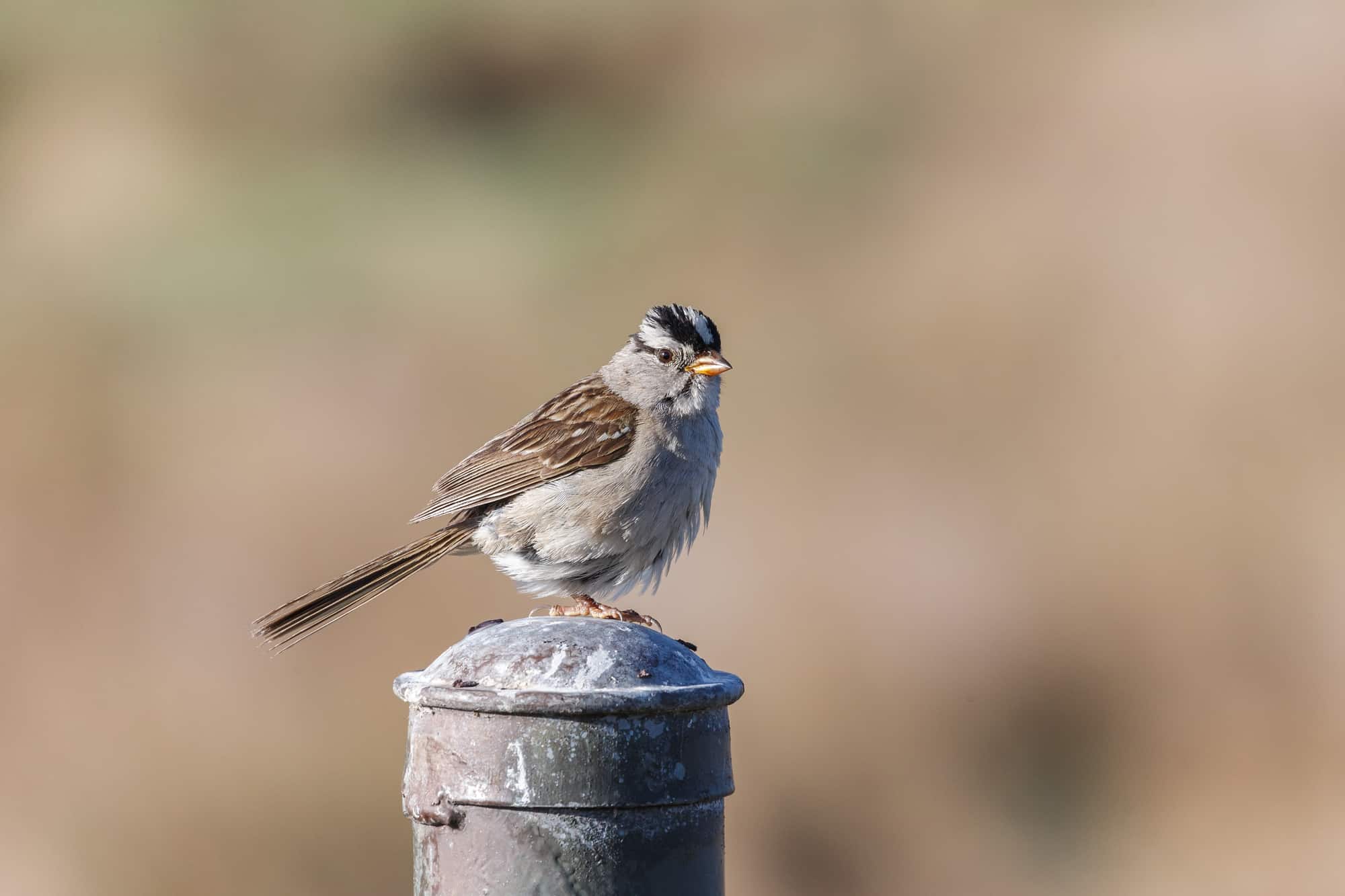
- Scientific Name: Zonotrichia leucophrys
- Length: 5.9-6.3 in (15-16 cm)
- Weight: 0.9-1.0 oz (25-28 g)
- Wingspan: 8.3-9.4 in (21-24 cm)
The white-crowned sparrow is fairly easy to recognize by their black and white striped head and orange-pink bill. They are also fairly large sparrows with long tails and necks.
You’ll only find white-crowned sparrows in mild Mississippi during the winter, and they are a rare sight here compared with states further north. They spend the breeding season in the far north of Canada, Alaska, as well as the Rocky Mountains.
These largish sparrows are most commonly seen moving around in mixed flocks over weedy and brushy areas in winter. You might even manage to attract them to your backyard by offering sunflower seeds, millet, and other types of bird food.
Vesper Sparrow
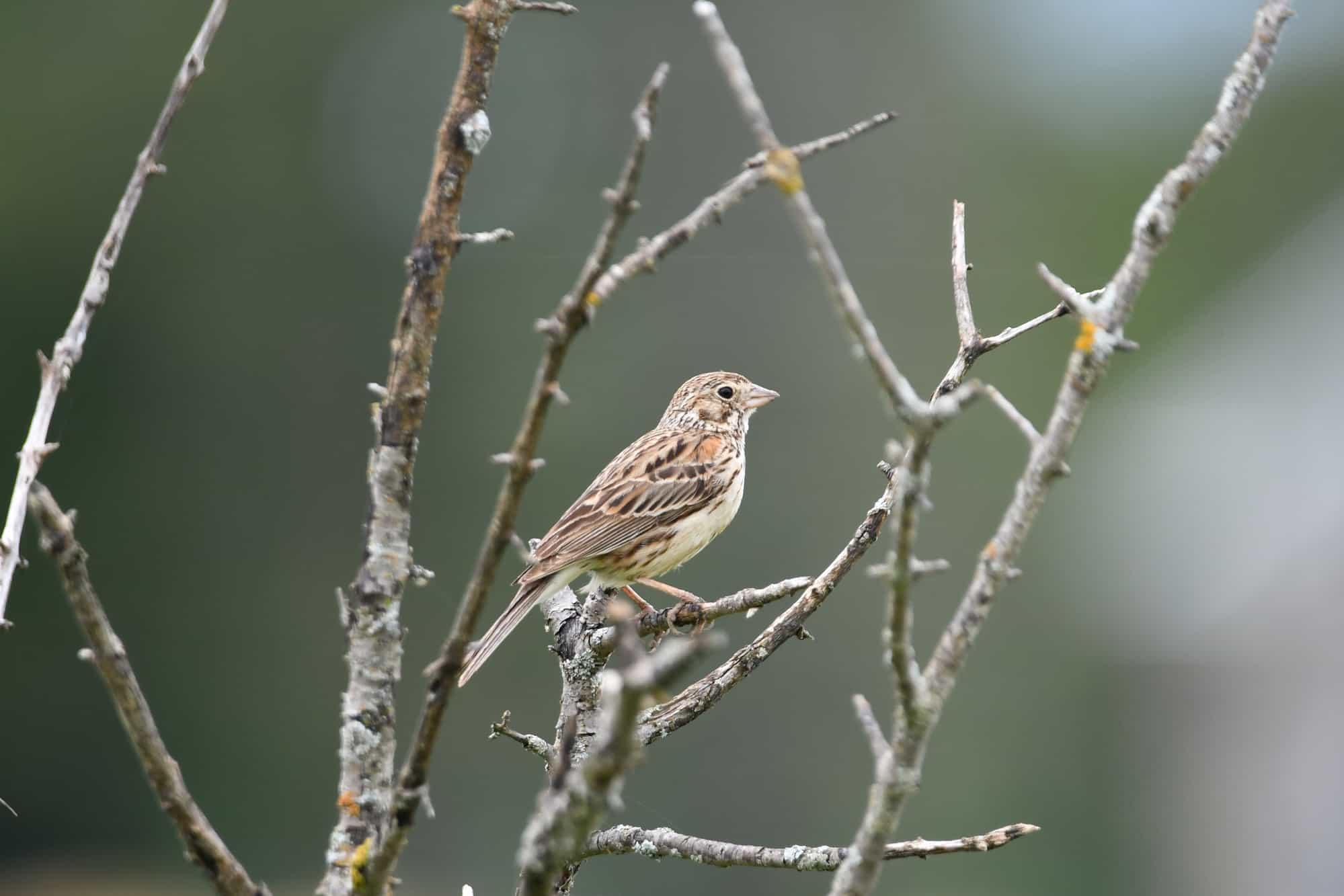
- Scientific Name: Pooecetes gramineus
- Length: 5.1-6.3 in (13-16 cm)
- Weight: 0.7-1.0 oz (20-28 g)
- Wingspan: 9.4 in (24 cm)
The vesper sparrow is similar in appearance to the savannah sparrow, but they’re slightly larger, with a longer tail, and without the yellow wash on their face. They can often be seen perching in the open on wire fences, and typically fly to treetops when disturbed.
Although they’re more common in the west of the country, vesper sparrows are a fairly rare sighting in Mississippi. You’ll only find them here during the winter when they form loose flocks in weedy fields with nearby trees.
Vesper sparrows numbers have declined by 37 percent during the last 50 years. This is mostly due to habitat loss in both breeding and wintering grounds. Additionally, modern farming practices, including pesticide use, hedgerow clearing, and early hay harvesting, have been detrimental.
Bachman’s Sparrow
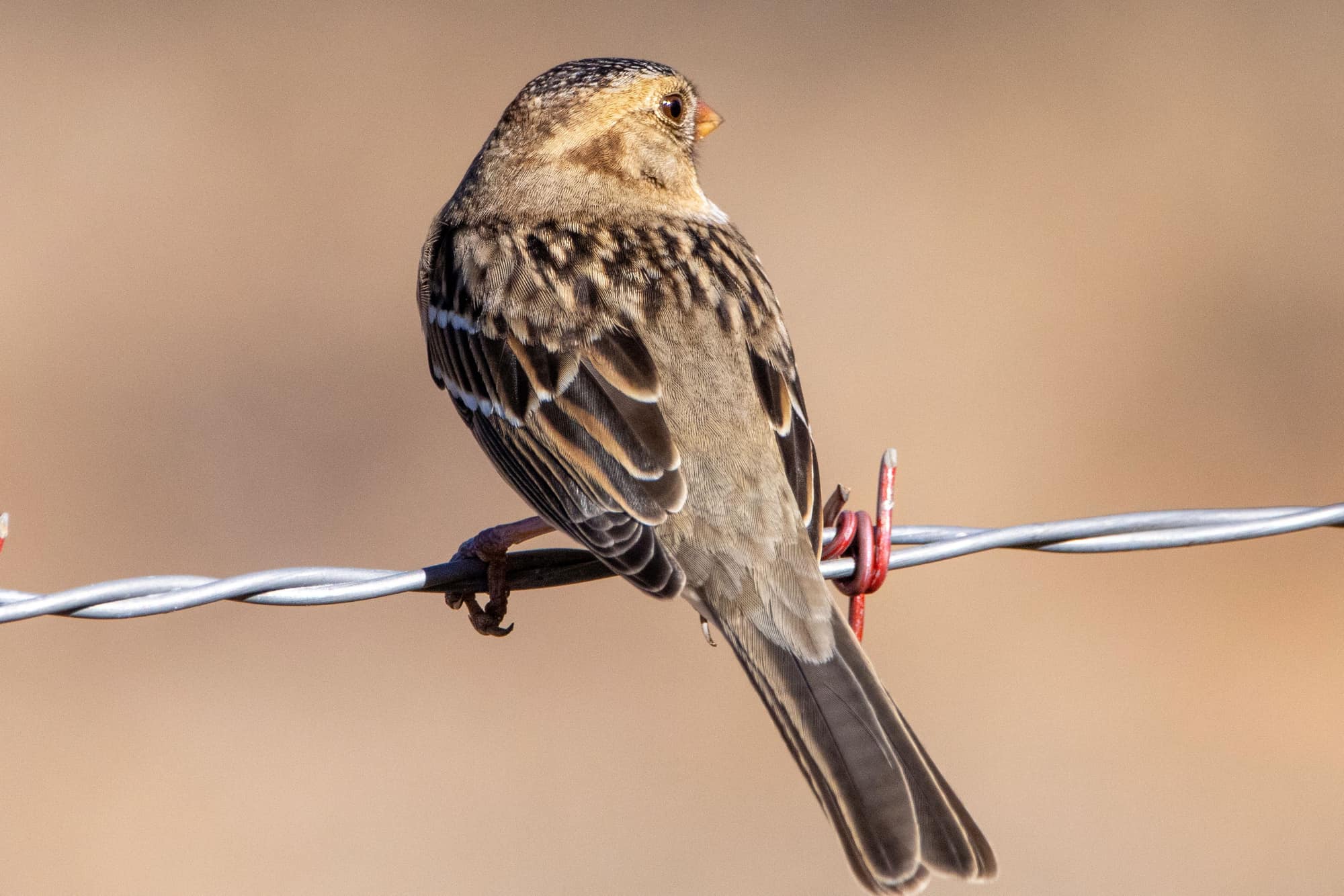
- Species Name: Peucaea aestivalis
- Length: 12.4 -15.2 cm (4.9 – 6 in)
- Weight: 18 – 22 g (0.6 -0.8 oz)
- Wingspan: 18.4 cm (7.2 in)
Bachman’s sparrow is a small, fairly indistinct brown sparrow with a white belly. Luckily they are the only members of the Peucaea genus in Mississippi and can be located and identified by their simple song – a throaty whistle followed by a short, sharp trill.
The population of this rare sparrow is contained entirely within the southeastern United States, from Florida to Eastern Texas. In Mississippi, they can be found all year in the southeast of the state but only in the northeast during the breeding season. Elsewhere, they are absent.
Sadly, Bachman’s sparrows are considered near threatened by the IUCN, and habitat loss may be partly to blame for their decline. Pine forests are their preferred breeding ground, which has led some people to call them the ‘pinewood’s sparrow’.
Nelson’s Sparrow
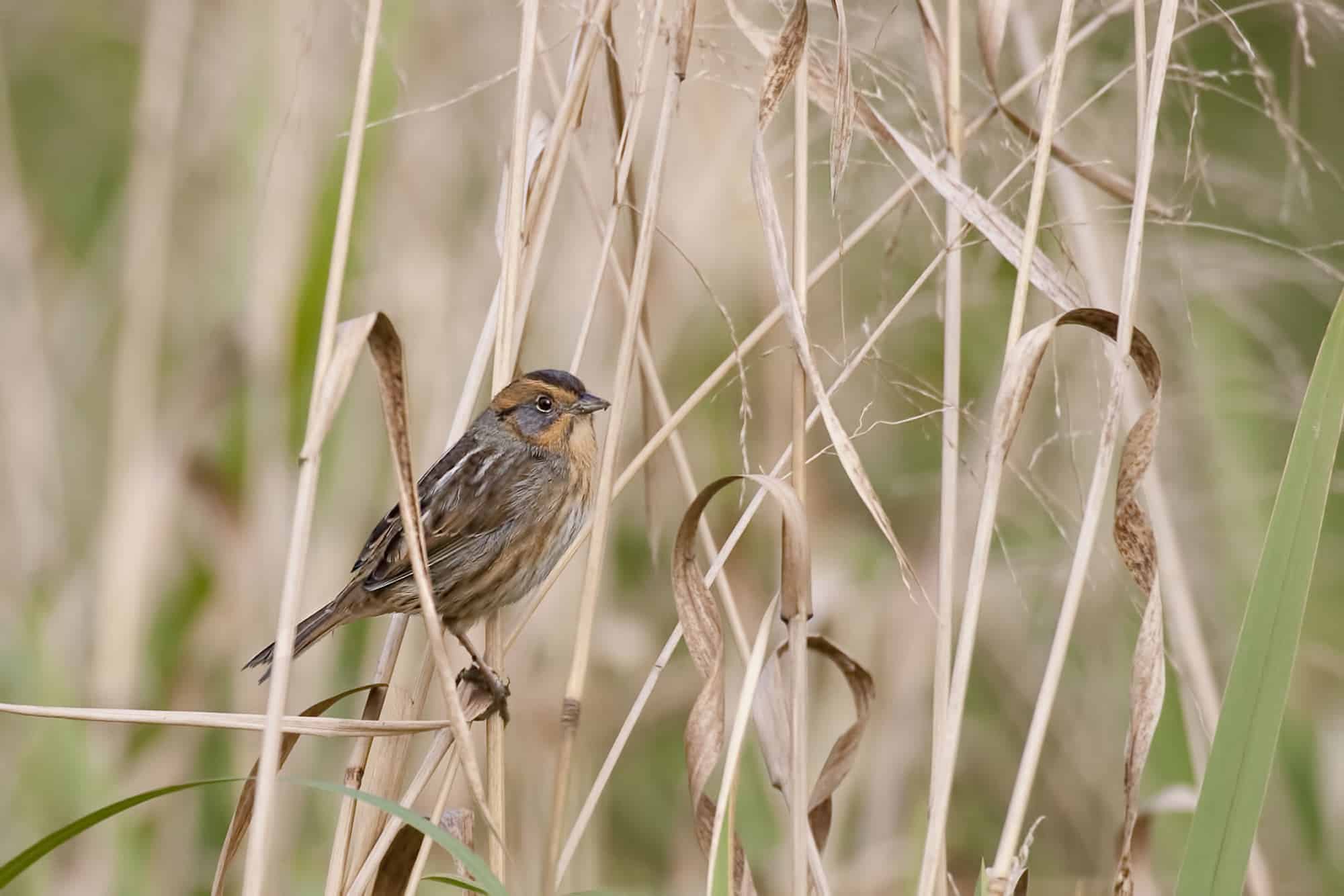
- Scientific Name: Ammospiza nelsoni
- Length: 4.3-5.1 in (11-13 cm)
- Weight: 0.6-0.7 oz (17-21 g)
- Wingspan: 6.5-7.9 in (16.5-20 cm)
Nelson’s sparrows are very similar to saltmarsh sparrows and were thought to be the same species until 1989! Now known to be distinct, it turns out that Nelson’s sparrow has a much broader distribution compared with its coastal-dwelling cousin.
Unlike the saltmarsh sparrow, this species overwinters on the coastline of Mississippi. Their preferred habitat is salt marshes but they can be occasionally found in freshwater wetlands, too. Curiously, they often sing at night with a hiss-like call.
Nelson’s sparrows rely mainly on insect species and mollusks as their chief source of food. Protecting their remaining marshland habitats may prove critical to their long-term survival.
Lark Sparrow
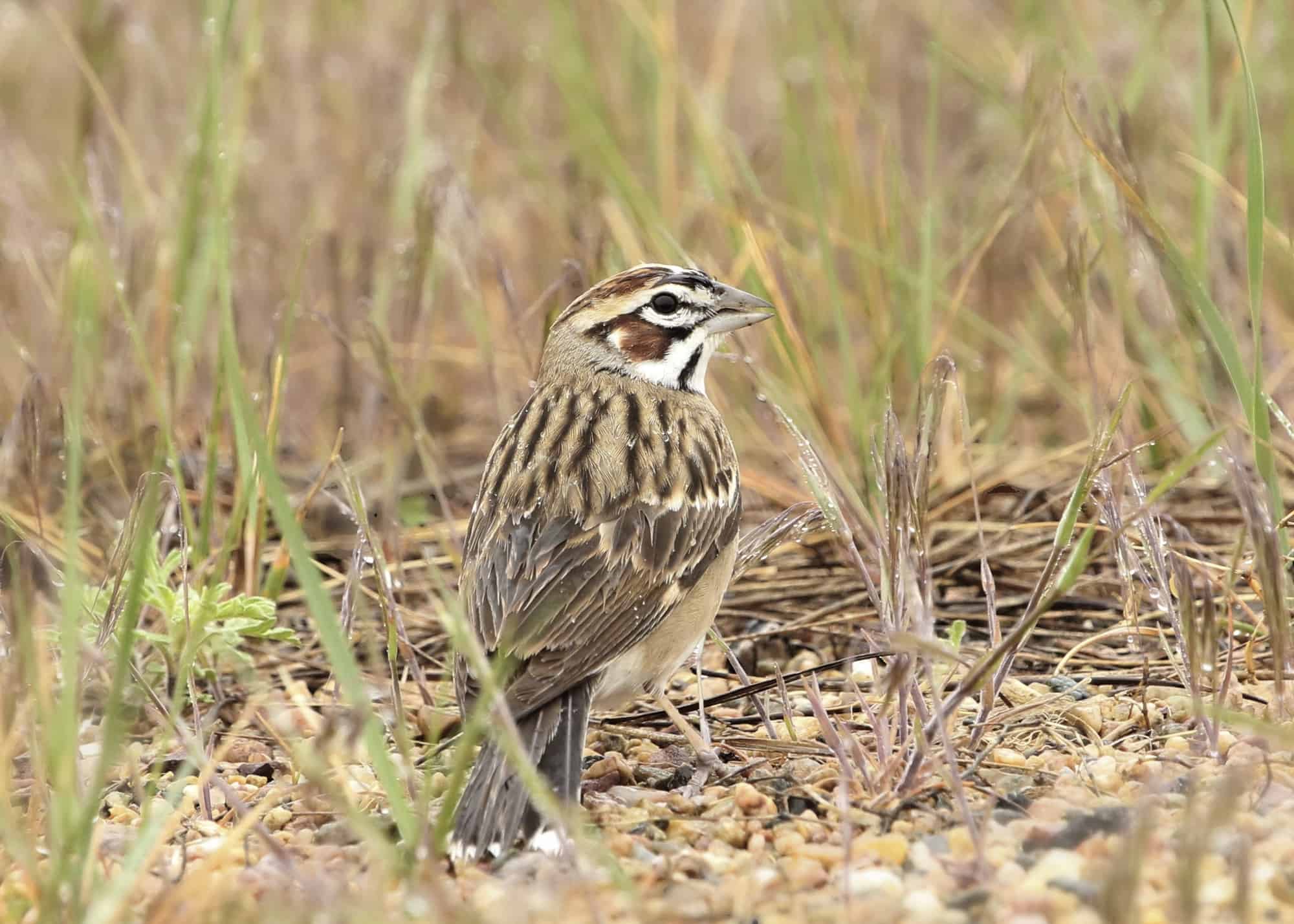
- Scientific Name: Chondestes grammacus
- Length: 5.9-6.7 in (15-17 cm)
- Weight: 0.8-1.2 oz (24-33 g)
- Wingspan: 11.0 in (28 cm)
Lark sparrows are most easily recognized by their large size, the bright white underside with a dark spot on their chest, and the white tips on their tail. Closer inspection also reveals distinct black stripes on their face and tan crown feathers.
These birds prefer to inhabit open grassy areas with scattered trees. They can be seen foraging on grazed livestock farms as well as on golf courses or well-kept lawns! Individuals sometimes join flocks of other small bird species.
Lark sparrows are rare birds in Mississippi, and can only be found here during the breeding season in the northeastern corner of the state. During nesting, both males and females collect materials such as grass and small twigs, but only females are allowed to construct the nest!
Lincoln’s Sparrow
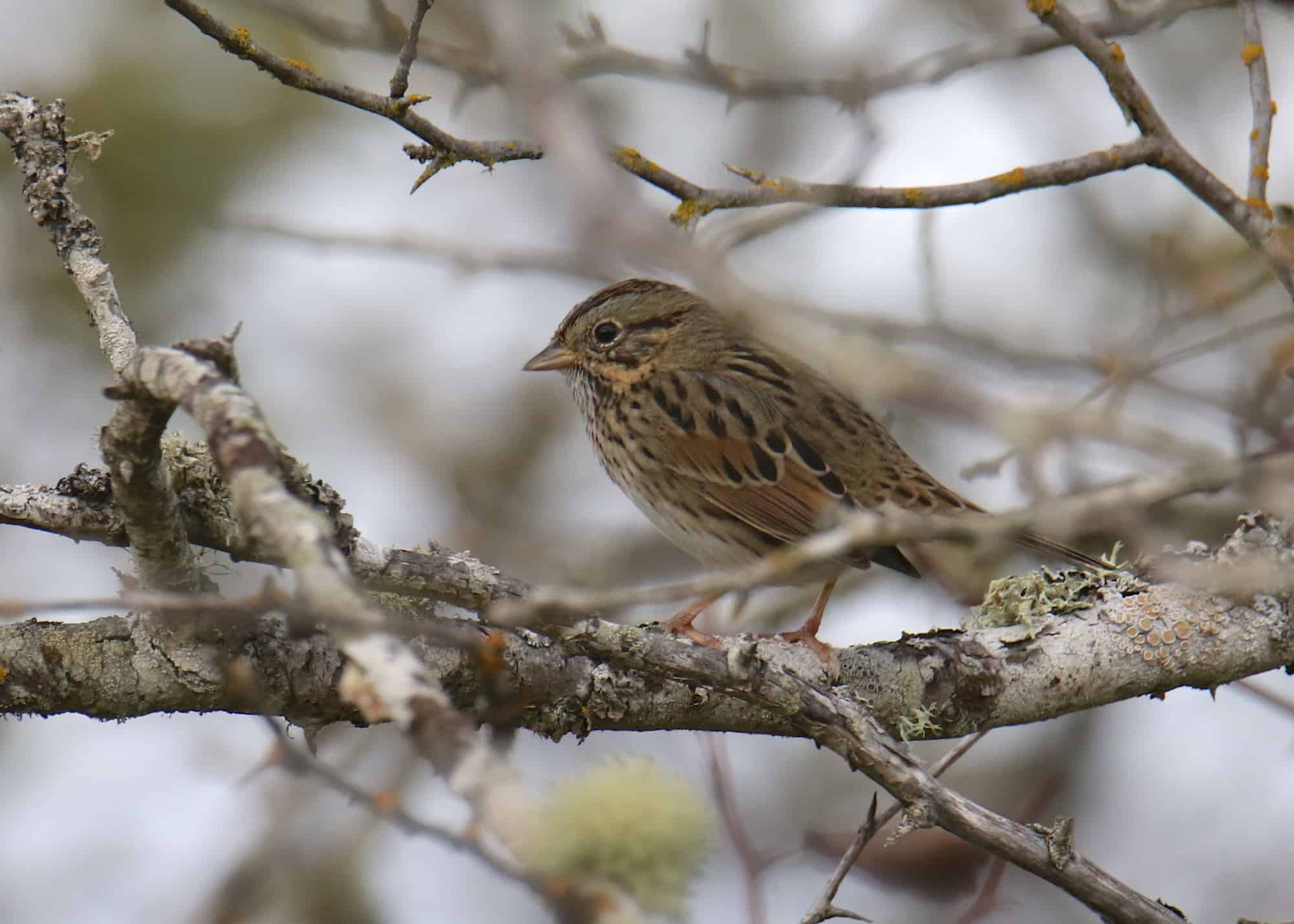
- Species Name: Melospiza lincolnii
- Length: 5.1-5.9 in (13-15 cm)
- Weight: 0.6-0.7 oz (17-19 g)
- Wingspan: 7.5-8.7 in (19-22 cm)
Lincoln’s sparrow looks rather like its cousin the song sparrow, but is slightly smaller, with a shorter tail and a more yellowish chest. They are typically found in brushy areas near water.
The delightful song of Lincoln’s sparrow is one of the most tuneful songs of any sparrow. Their sweet trills interspersed with silence cast a soothing backdrop that could even be described as therapeutic.
These distinctive sparrow songs are also one of the best ways to locate and identify this plain-looking bird. As infrequent winter visitors to the south of Mississippi, not everyone will be lucky enough to hear these shy birds here, but it’s something to savor if you do.
Henslow’s Sparrow
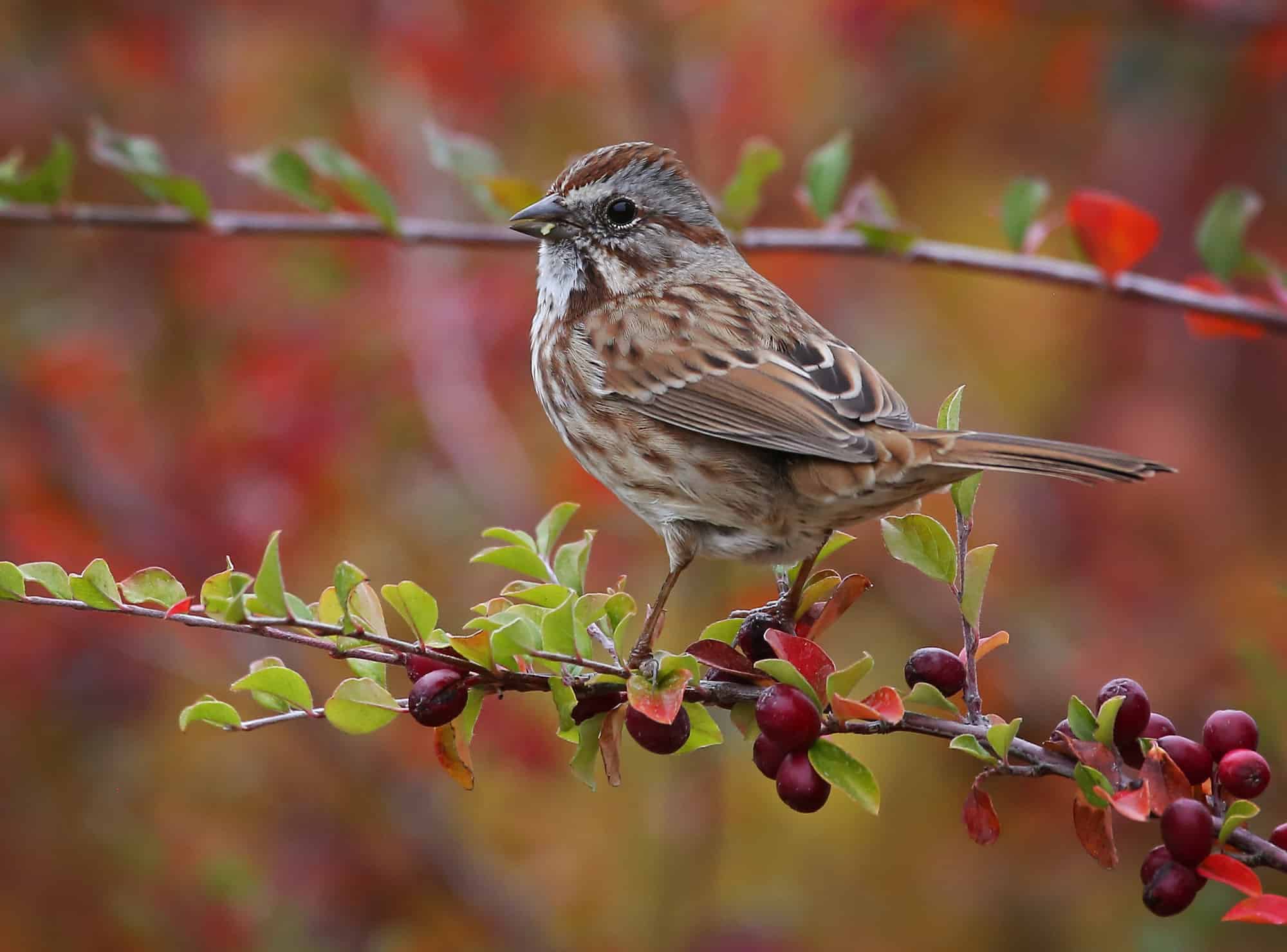
- Species Name: Centronyx henslowii
- Length: 4.75 – 5.25 in (12–13 cm)
- Weight: 0.5 oz (14 g)
- Wingspan: 7 – 7.5 in (18 – 19 cm)
Henslow’s sparrows are extremely small, short-tailed, and large-headed sparrows with a relatively large beak.
Despite being a significant part of their confined winter range, the rare Henslow’s sparrows are rarely seen in Mississippi. You’ll only find them in the southern half of the state among damp grassy meadows such as in the Mississippi Sandhill Crane National Wildlife Refuge.
Sadly, this bird’s preferred habitat has been decimated by modern agriculture, and these sparrows’ numbers have plummeted along with the watery wildflower meadows that they rely on.
With its greenish-yellow head and speckled plumage, this tiny sparrow is highly camouflaged and prefers wetland habitats far from human contact. Even the squeaky call of this timid bird is very discreet, and when scared, they are more likely to run through dense grass than to fly.
LeConte’s Sparrow
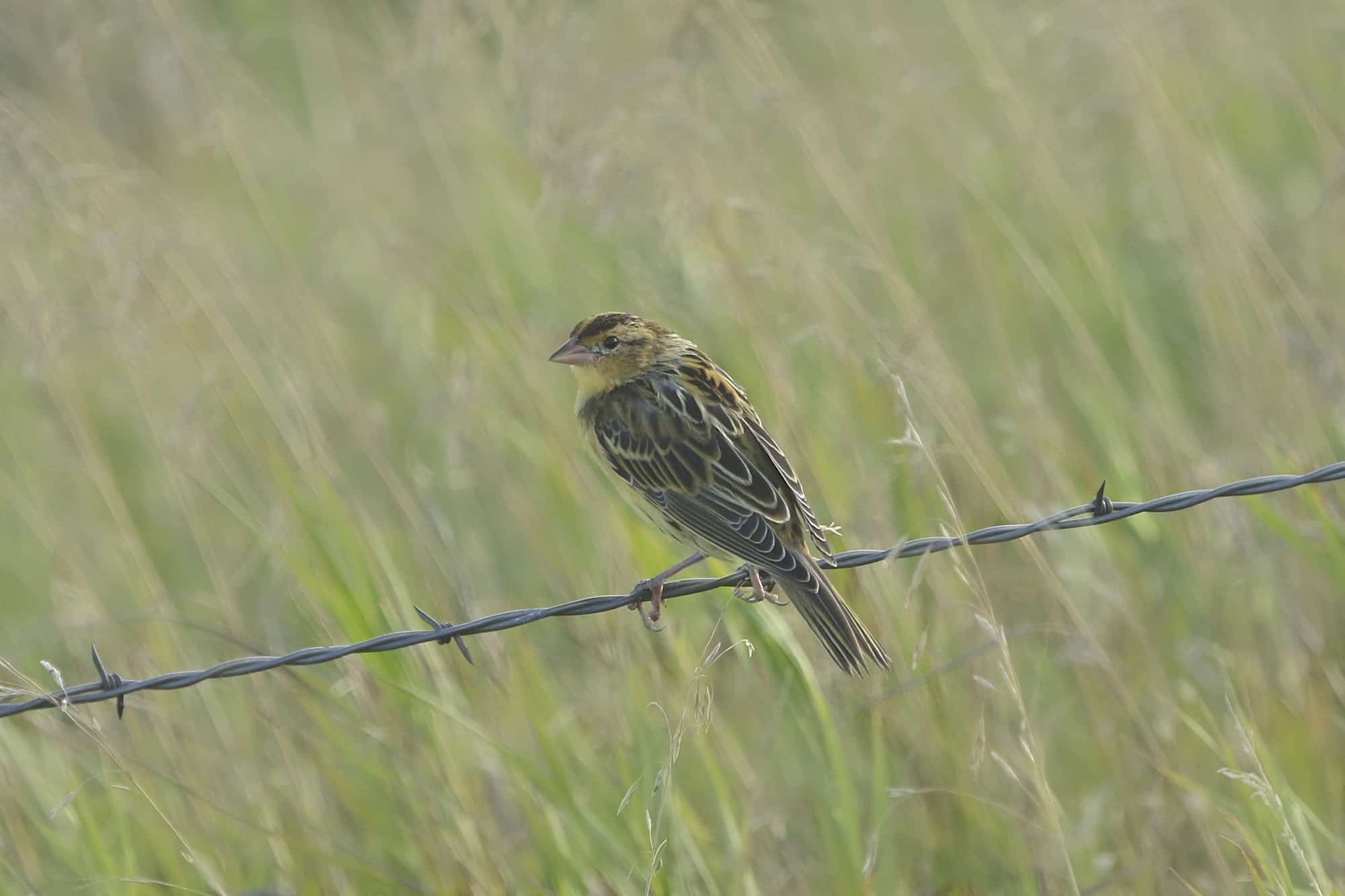
- Species Name: Ammospiza leconteii
- Length: 4.7-5.1 in (12-13 cm)
- Weight: 0.4-0.6 oz (12-16.3 g)
- Wingspan: 6.3-7.1 in (16-18 cm)
Another miniature bird, LeConte’s sparrow only weighs around half an ounce! They can be told apart from the closely related Henslow’s sparrow by their more orangey plumage, and smaller bill.
These sparrows also tend to favor slightly drier meadows than Henslow’s sparrow, and unlike their cousin, they can be found throughout Mississippi during the winter. In the summer they mostly breed in Canada.
A rare sighting in Mississippi, but you might be lucky enough to see one if you’re out exploring wild grasslands here. Listen out for their grasshopper-like, buzzing call.
Grasshopper Sparrow
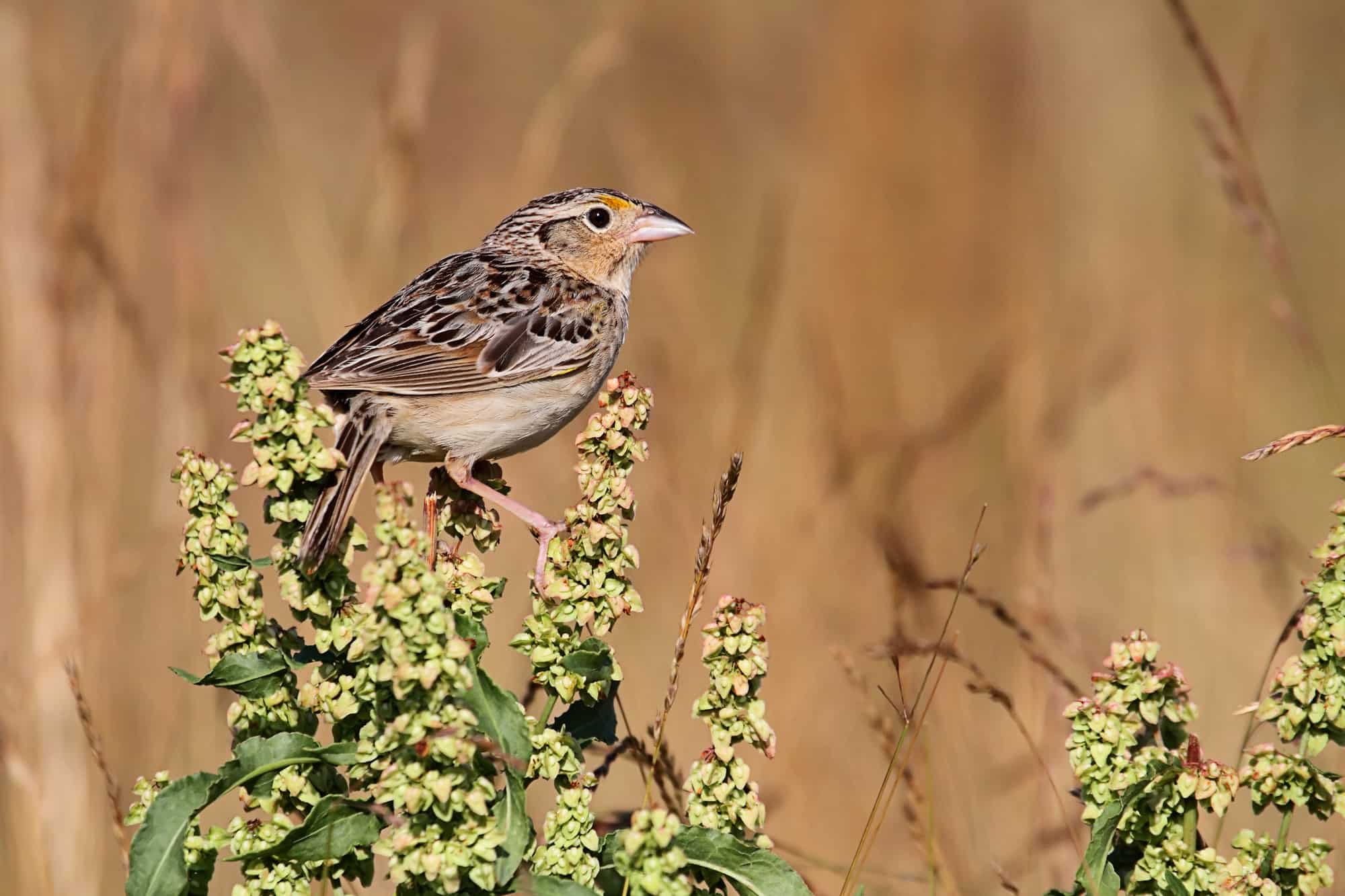
- Species Name: Ammodramus savannarum
- Length: 4.3-4.5 in (10.8-11.5 cm)
- Weight: 0.5-0.7 oz (14-20 g)
- Wingspan: 7.9 in (20 cm)
The third member of the Ammodramus clan in Mississippi is the Grasshopper sparrow. Like LeConte’s sparrow, the grasshopper sparrow is a tiny bird with a grasshopper-like call, hence its name!
They prefer to inhabit drier ground than either LeConte’s sparrow or Henslow’s sparrow and are a duller, browner color than either of its cousins.
Grasshopper sparrows have an interesting distribution in Mississippi. According to my Sibley’s Guide to Birds, they can only be found in the south during the winter, and only in the north during the breeding season. It’s only in a narrow band in the middle of the state that you’ll find them year-round!
Grasshopper sparrows are sadly declining at a rapid rate in America, with an annual decline of 3.48% recorded recently. The loss of native grasslands to intensive agriculture is thought to be the chief culprit for their demise.
Very Rare Sparrows in Mississippi
According to bird watcher reports at ebird.org, all of the above sparrows have been seen by between 1 in 4 to 1 in 1000 bird watchers. But there are a few sparrow species that are even rarer than that! Let’s take a quick look at those here.
Clay-colored Sparrow (Spizella pallida)
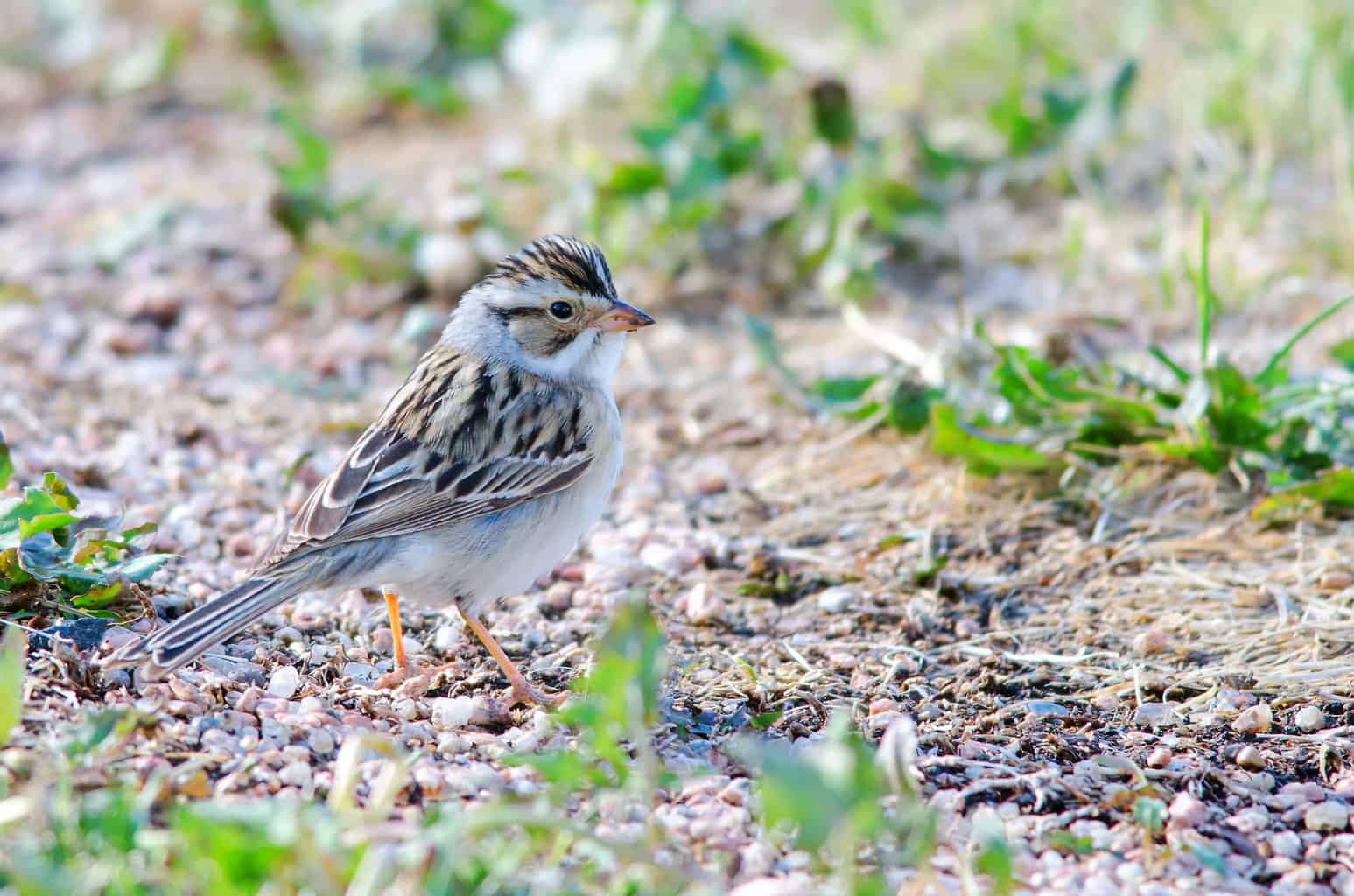
The aptly-named clay-colored sparrows are only occasional vagrants in Mississippi. During the winter they’re only regularly found in Texas and more central states. In summer they breed in the Northern USA and Canada. You’re most likely to see them here during the spring and fall on their annual migration routes.
Harris’s Sparrow (Zonotrichia querula)
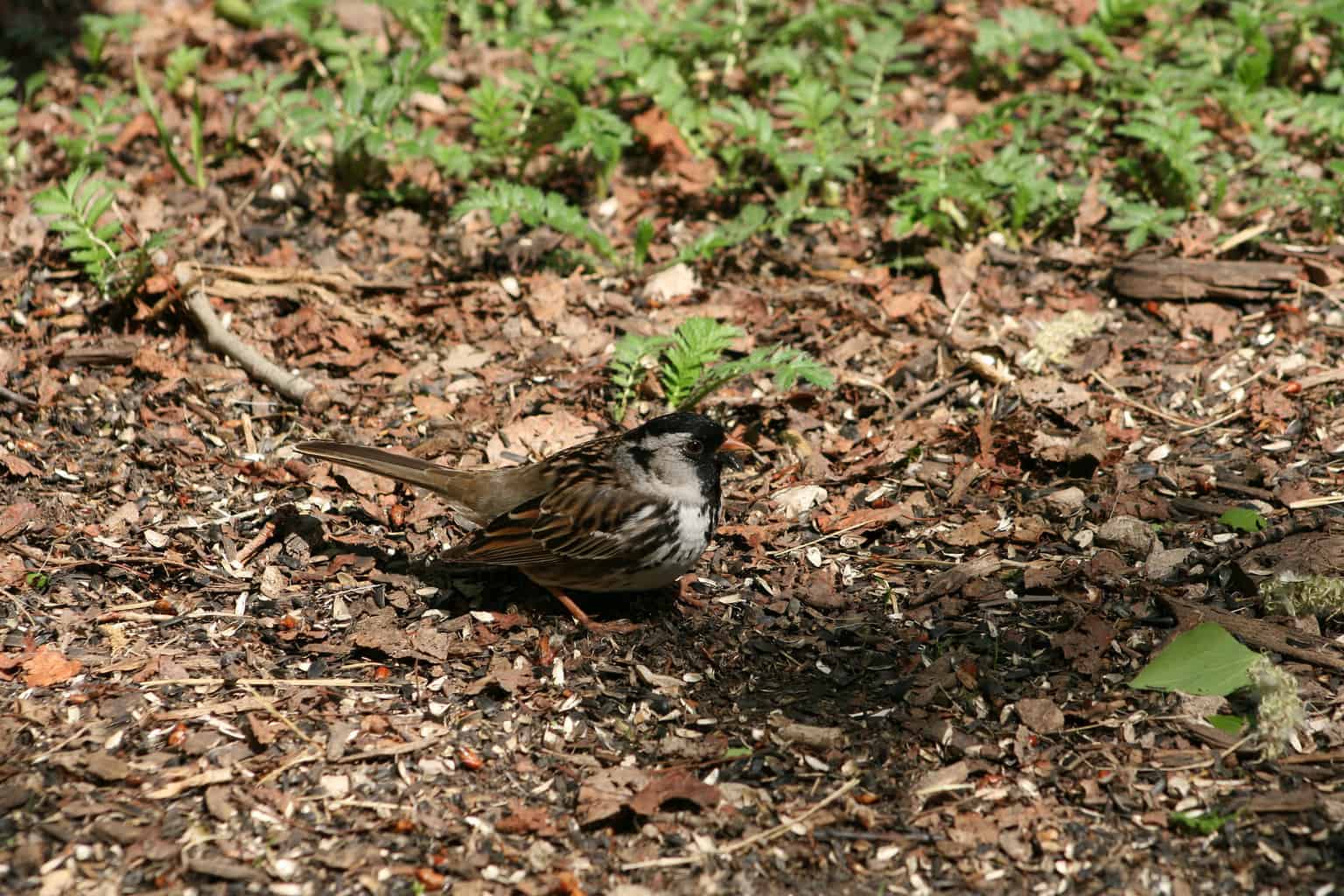
Harris’s sparrow is one of the most easily recognized sparrows in North America owing to their black crown and facial plumage. Seeing them in Mississippi is cause for excitement since they only make a very occasional appearance here when they drift from their wintering grounds in more central states.
American Tree Sparrow (Spizelloides arborea)
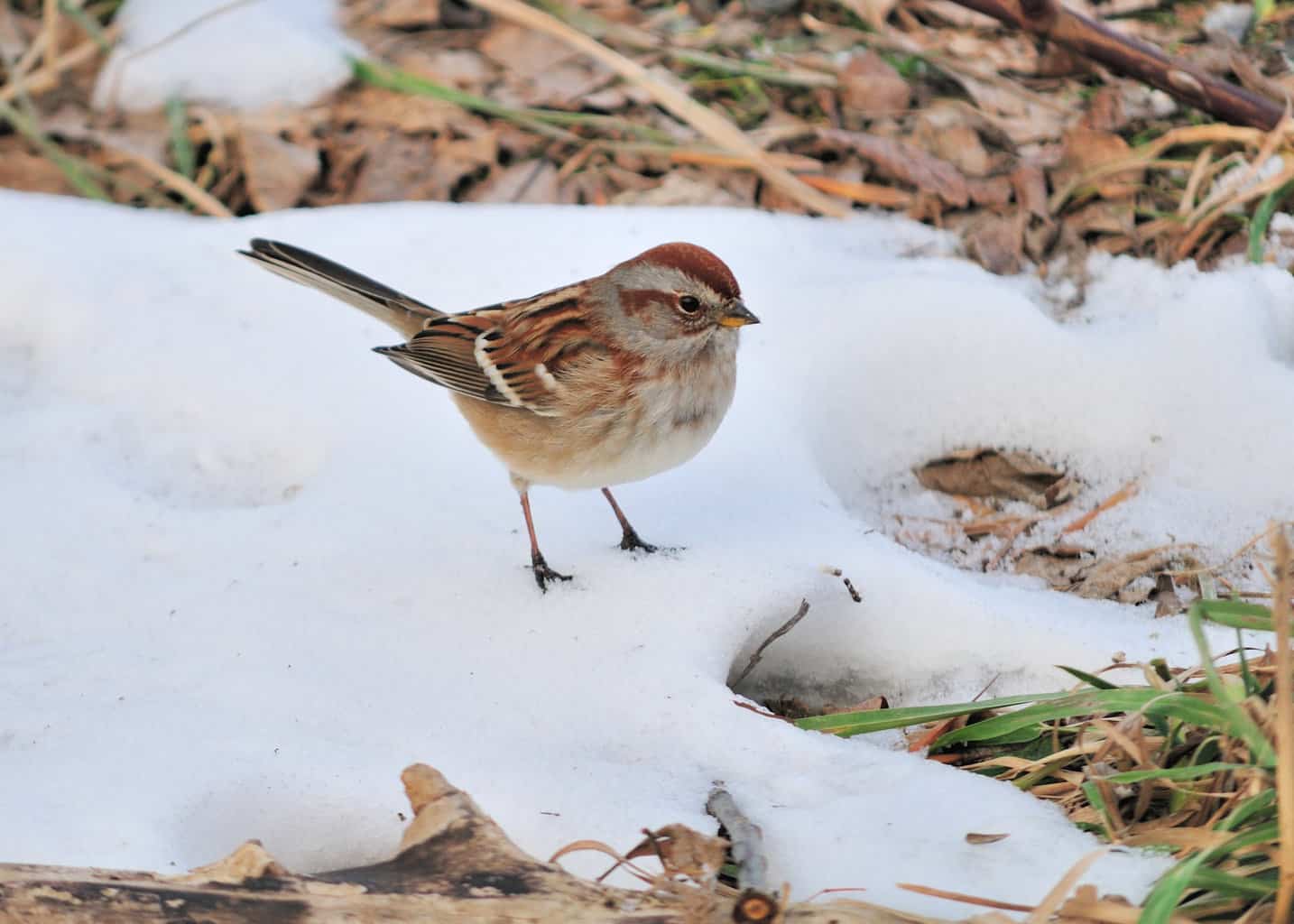
American tree sparrows are a common species further north, but this hardy bird rarely ventures this far south. The only place you’ll see these cousins of the field sparrow in Mississippi is in the very north – and don’t go looking in trees! Despite their name, American tree sparrows actually spend most of their time on the ground.
Green-Tailed Towhee (Pipilo chlorurus)
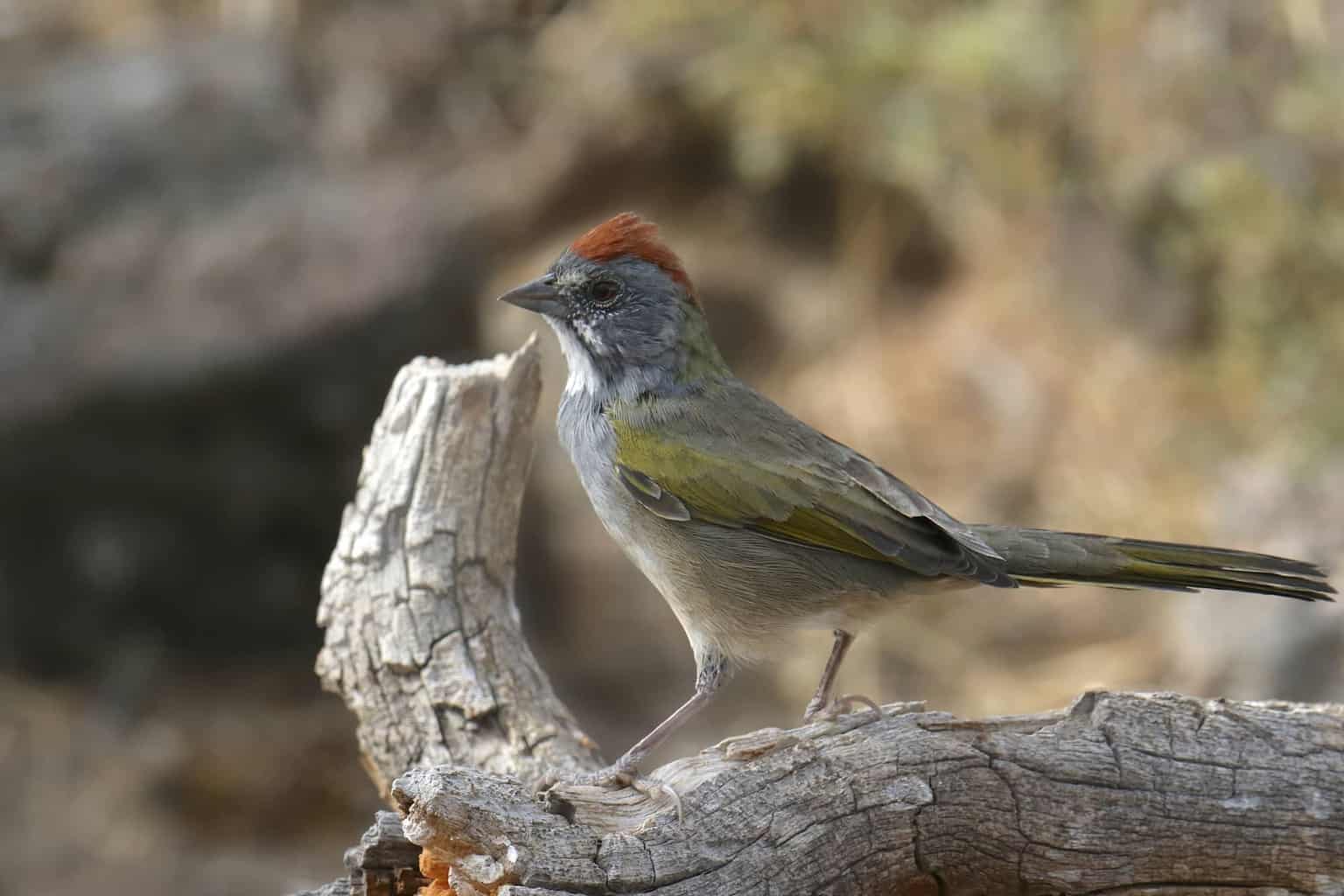
Green-tailed towhees are exotic-looking birds that typically inhabit the Western United States and Central America. Only very rarely will they drift this far east, but they are very occasionally spotted in the northwest of Mississippi.
Spotted Towhee (Pipilo maculatus)
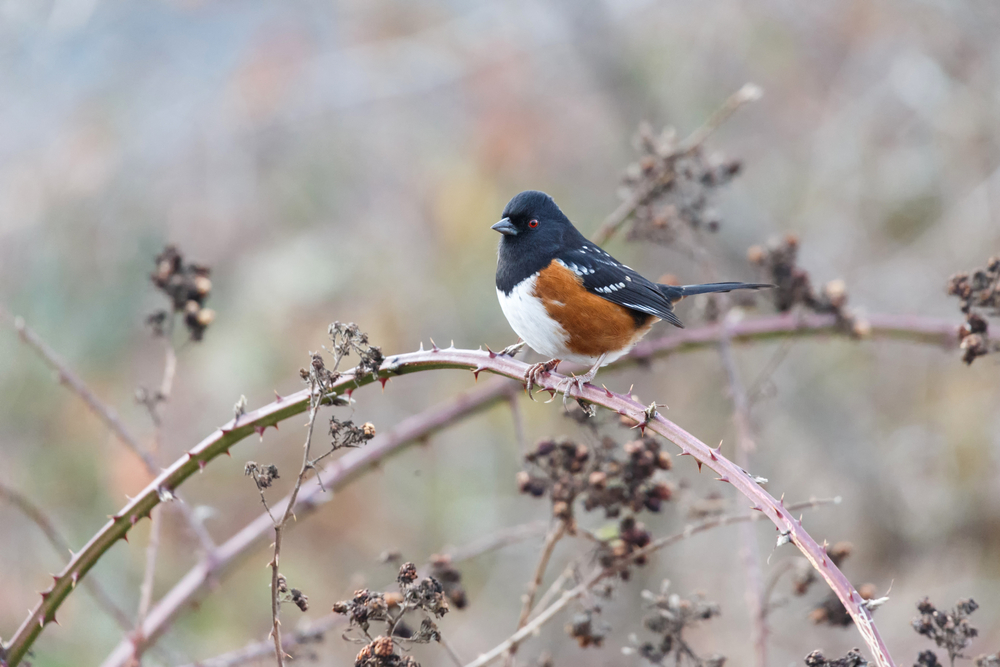
A close cousin of the eastern towhee, the spotted towhee looks very similar except for the prominent white spots on its wings and its brighter red eyes. They’re so closely related to their eastern counterparts that on the rare occasions when they share territory, they can mate and produce hybrid offspring!
Conclusion
Mississippi boasts a wealth of sparrow species, and some of them remain numerous, especially during the mild, winter months here.
Other sparrows, however, have been severely impacted by invasive agricultural developments that have cost them their natural habitats. The American Bird Conservancy (ABC) has been doing great work to protect sparrows and is always looking for people to help their cause.
Mississippi’s extensive lowland plains are home to many more birds than just sparrows! Great Horned Owls, Hooded Warblers, and Ruby-throated hummingbirds are but a few of the birds we’ve covered in our exciting guide to 24 of the most beautiful birds in the Magnolia State.

